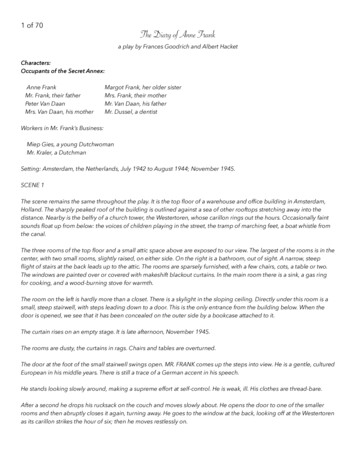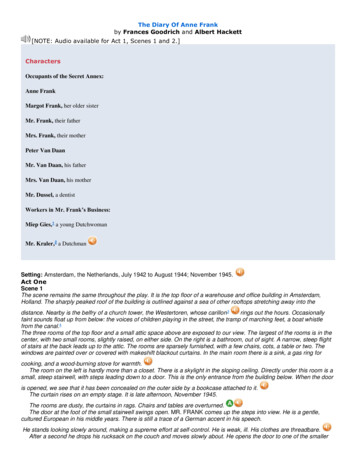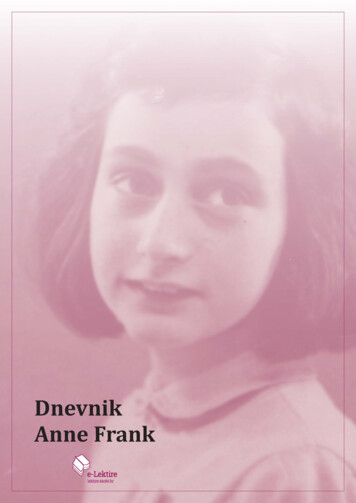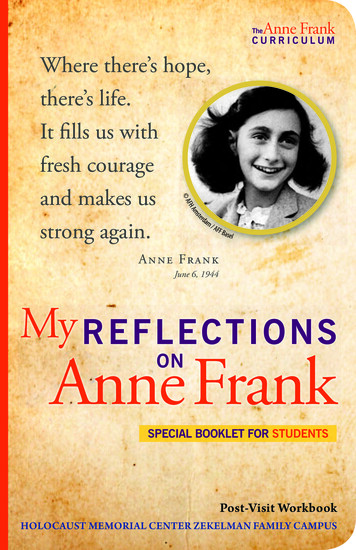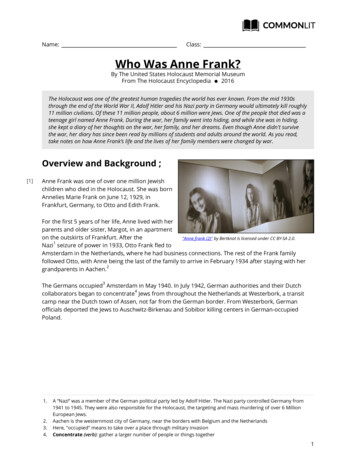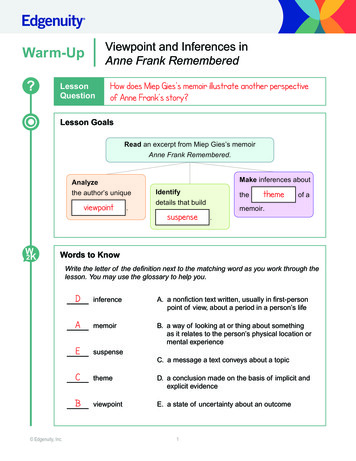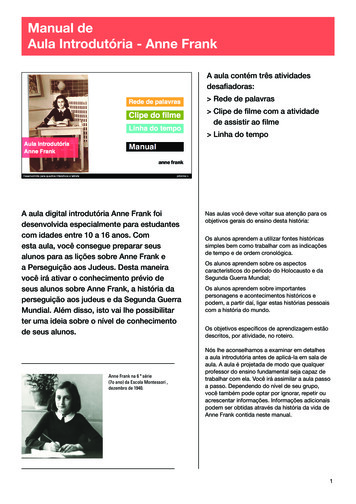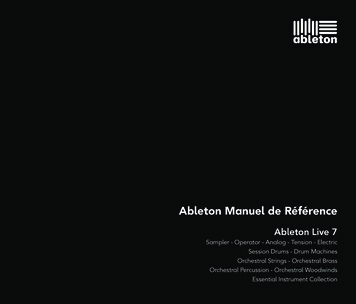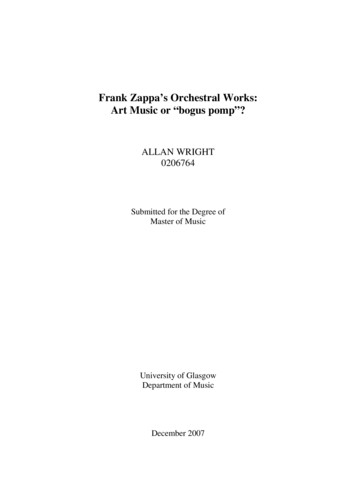
Transcription
Frank Zappa’s Orchestral Works:Art Music or “bogus pomp”?ALLAN WRIGHT0206764Submitted for the Degree ofMaster of MusicUniversity of GlasgowDepartment of MusicDecember 2007
r 1 – Making connections – Frank Zappa, Stravinsky and Varèse4Chapter 2 – Frank Zappa the Composer13Chapter 3 – The Music - Making Sense of Zappa19Conclusion63Bibliography68
iiAcknowledgementsI wish to acknowledge the help and support of the many people that havemade my first venture into this extended piece of writing possible. Firstly I wish tothank my parents Allan and Ann Wright and my sister Dr Elaine Baruah for theirconstant support, both emotional and financial for which this Masters year would nothave been possible. I also wish to thank the staff of this vibrant and friendlyDepartment of Music that has been my second home for over five years, in particularthe Head of Department Mr William Sweeney, Mr Tommy Cameron, Mrs DianeThomson, Dr Martin Cloonan, Professor John Butt and most of all my advisor ofstudies Dr David Code, who has been given the challenge of adopting me as hisstudent.Throughout this year the support of my friends and colleagues cannot go unmentioned.They include, Dr David McGuinness, Catherine Strachan, Aileen O’Neill, SannaRaninen, Eugene de Klerk, Anne-Marie Millim, Katy Cooper, Jo Clements, ChrisHutchings, Drew Hammond, Neil Davidson and Neil McDermott.The greatest thanks go to my two daughters Kirsty and Shona, from whom I havebeen too absent, and it is they that I dedicate this thesis to.
1IntroductionThis dissertation was conceived in response to the many authors, notablyJonathan Bernard, Matthias Kassel, Ben Watson and Kevin Courrier, who suggest thatFrank Zappa’s “art” music contains stylistic references to early 20th centurycomposers as Igor Stravinsky, Eric Satie, Charles Ives, John Cage and EdgardVarèse.1On the whole such studies, though undoubtedly important contributions toZappa criticism, stop short of further specific investigation as to why Zappa’s musicevokes the style of these composers.If we are to make an attempt at understandingZappa’s music fully in this light, it is necessary to examine these assertions moreclosely, in order to discover the degree to which Zappa’s music has absorbedparticular stylistic nuances from each of the aforementioned composers.For the purposes of this first tentative step towards an in-depth investigationinto stylistic similarities between early 20th century modernists and Frank Zappa, Ihave chosen to concentrate primarily on the influence of Edgard Varèse.Toexamine all the possible stylistic references to 20th century composers’ noted byBernard, Kassel and Courrier, would go beyond the limits of this initial dissertation.The study is conducted as a narrowly focused comparative examination, wherespecific Zappa pieces are analysed in order to show how they relate to Varese’smethods of composing. In my analyses that follow, I have consulted Jonathan1Throughout the bibliography that I have used for this dissertation there are associations made to theearly 20th century modernists I mention. See: Jonathan W. Bernard, “Listening to Zappa,”Contemporary Music Review, 18, 4 (2000): 63-103; Matthias Kassel: “Frank Zappa and the idol of hisYouth” in Meyer and Zimmermann eds., Edgard Varese, Composer, Sound Sculptor, Visionary(Suffolk: 2006); Kevin Courrier, Dangerous Kitchen: The Subversive World of Frank Zappa (Toronto2002); Ben Watson, Frank Zappa: The Negative Dialectics of Poodle Play (London 1996)
2Bernard’s book The Music of Edgard Varese as guidance on Varese’s technique, aswell as the opinions of Varèse himself as most famously exemplified in the“Liberation of Sound” lecture he gave in 1936.2 This will form a basis to which wecan compare certain elements of Zappa’s music to, and in turn ascertain the degree towhich Zappa’s music uses distinctively “Varèsian” ideas.Zappa’s works that arespecifically referred to appear in the following CD releases: The Perfect Stranger, TheLondon Symphony Orchestra Volume II, The Yellow Shark and Burnt WeenySandwich.The analyses will consider examples of both acoustic and electronicallyrecorded pieces from within this discography.In Chapter 1, I have included specific comments the authors I have chosen torespond to have made.This provides the initial platform of inquiry, and one thatalso reveals the unrealised nature of some elements of Zappa criticism I am aiming toexpand upon.Beginning with Ben Watson and Kevin Courrier, I examine some oftheir assertions about Zappa’s music and early 20th century modernism. Both authorsrepresent a major contribution to Zappa criticism, but centre mostly on Zappa’s rockoutput and the environment in which such music was conceived.Thereafter, Iconsider contributions made from Jonathan Bernard and Matthias Kassel in theirmove towards addressing Zappa’s “art” music, and also reflect upon Elliott Carter’sviews on Varèse in an attempt to consolidate my comparison with Zappa.From Chapter 3 onwards, I will examine these assertions in several analyses ofZappa works, chosen particularly to reflect some of the sound-scapes Varèse’sorchestrations display, and to associate these to Zappa.A discussion of “BogusPomp” centres on block-structure and timbre, and examines the possible origins ofhow Zappa created the piece in view of his skills as a studio engineer and observer of2See Jonathan W. Bernard, The Music of Edgard Varèse (Yale 1987) and Edgard Varèse, “TheLiberation of Sound,” in Strunk ed., Source Readings in Music History (Yale 2000): 1049-1050.
3Varèse’s attention to timbre.Following this, an analysis of “The Girl in theMagnesium Dress” addresses the question of pitch stasis as described by Bernard, andto consider the extent to which this represents a specific technique of Varèse.Thereafter I discuss isolated elements in various other Zappa works, and examine theextent of Varèsian influence they contain.Some critics might object that the “art” music influence on Zappa hasgenerally been over-exaggerated, possibly even ascribing to Zappa the same elevatedsense of prestige he himself satirised in such music as “Bogus Pomp.” But it isundoubtedly the case that Zappa held Varèse in high regard, from his first experienceof listening to Ionisation to his own aspirations of compositional technique explicitlydescribed in his own words as Varèsian. Whether or not it is true that Zappa wishedto be regarded on the same level as Varèse, he clearly acknowledged the aestheticallegiance in such comments as this one, quoted in The Real Frank Zappa Book: “Inmy compositions, I employ a system of weights, balances, measured tensions andreleases – in some ways similar to Varèse’s aesthetic.”3 He goes on to describe thisas being similar to a “Calder mobile,” a device with various weights, suspended andbalanced with each other by the varying distance between them. Such a suggestivebut relatively general comment challenges us to diagnose exactly how and to whatextent Zappa’s “system” actually can be described, and whether or not it helps to hearhis music in light of the Varèsian “measured tensions and releases” he sees asfundamental to the “Varèsian aesthetic.” That, in short,is the principal aim of thisthesis.3Frank Zappa with Peter Occhiogrosso, The Real Frank Zappa Book, (London 1989): 162-163.
4Chapter 1Making connections – Frank Zappa, Stravinsky and Varèse.The principal focus of much existing Zappa criticism centres on thecommercial or popular material Zappa produced with the Mothers of Invention andhis later touring bands.There has been much written about this side of Zappa’swork including many books, articles and interviews that address the mixture of stylewithin the overall musical material he produced. In order to understand the reasonswhy such stylistic diversity exists, Zappa’s social, musical, intellectual and politicalinteractions have been extensively explored. Many interviews and reviews of Zappaexist largely within the popular music press ranging from NME to the Popular Musicjournal. More of his attitudes towards American culture, freedom of expression andsocial issues are examined in Watson, Negative Dialectics; and Richard Kostelanetzin Rocco ed.,The Frank Zappa Companion: Four Decades of Commentary (London1997).There remains however noticeably less critical response to his contemporary“classical” or “art” music which he composed alongside the commercial rock andimprovisatory jazz output.This thesis is primarily concerned with Zappa’s “art”music, where the intention is to investigate the degree to which he attempts to createhis “Varèsian aesthetic,” and to consider this on reflection with the authors previouslymentioned.From the outset of such a discussion, the differentiation between thestyles of Zappa’s music present problems in terminology. For the purposes of thisdissertation I have used the terms “art music” and “orchestral music.” I acknowledgethat these terms are perhaps unsatisfactory descriptions, but they are used only in anattempt to make a distinction between styles in Zappa’s music.
5“Weird abuttals”In this introduction to the analyses that form the subject of the next chapter, it isnecessary to present some examples of how critics compare Zappa’s music to themusic of many early 20th century composers.Ben Watson incorporates both ofZappa’s styles in his considerations of early 20th century compositional influences inFrank Zappa: The Negative Dialectics of Poodle Play. In his opening chapterWatson begins to make the connection between Zappa, Stravinsky and Varèse:The technical freedom of Varèse, which allowed him to deal with sound inthe manner of the abstract painter, balancing and contrasting blocks ofsound, is a product of his Dada-Futurist social programme. Varèse is asaware as Stravinsky of the excitement of a crashing pulse, but offsetsunrelated rhythms, making the admixture a matter of textural collage.Distracted by the vocal icing on Zappa’s music, people frequently fail tolisten to it as sound: his weird abuttals of genre in fact work likeextensions of Varèse’s contrasting sonic blocks.4Here, Watson suggests the origins of Zappa’s methods of placing unrelated musicalepisodes together. Such “technical freedom” in the shape of “sonic blocks” asexemplified in Varèse, might account for this, especially if Zappa’s Dadaist leaningsare to be taken into account. One of Varèse’s key compositional models was tocombine non-blending sounds, where blocks of these sounds are balanced andcontrasted with each other.5As can be seen from Zappa’s quote in the previouschapter, he clearly saw his own methods of composing to be concurrent with Varèse.It is interesting to observe then his aesthetic comparison to a Calder Mobile thatdemonstrates “weights”, “balances” and “releases.”Watson implies here that aswith Varèse, Zappa embraced the same technical freedom in composition, without theconstraints of constructing his music on any compositional system that might beassociated with serialism or octatonicism or other examples of a given pitch-class45Ben Watson, Negative Dialectics : 6-7See Varese in “The Liberation of Sound”
6technique.Watson also urges us to listen to Zappa’s music not only as music, butspecifically as sound, which opens our ears to some of the underlying technical detailthat could exist. Some of this detail he is suggesting therefore could be interpreted as“extensions of Varèse’s sound blocks.”The question thus arises: do Zappa’s “weird abuttals” demonstrate precisesimilarities with Varèse’s “sound-block” technique?In chapter three, this view istested in an analysis of Bogus Pomp, alongside suggestions that Zappa’s chosentimbre relates to a specific approach to the organisation of form, thus addressingWatson’s collage idea.For Zappa, the combination and diversity of timbre thatexists within the percussion section of the orchestra are a major force in his music,timbres that Watson also links to Varèse: “Varèse showed how the orchestra could beorganized to contrast musical materials, opening the ear to the marimba, woodblocksand drums ”6 As we shall observe in “Bogus Pomp,” Zappa’s combinations oftimbral qualities are noticeably similar to Varèse’s, in particular, combinations thatinvolve woodblocks, drums and low brass.Indeed, Kevin Courrier also makes thislink in describing Ionisation that the piece: requires a group of thirteen who can play a total of thirty-seven percussioninstruments, including gong, Chinese blocks, tam-tams, snare-drums andCuban claves .Zappa would draw on many of these innovations in dozensof his own compositions.7Courrier’s proposal of this relatively clear timbral link between Varèse and Zappa isclearly desiring of further elaboration.67Ben Watson, Negative Dialectics: p59.Kevin Courrier, Dangerous Kitchen p27.
7Watson’s “weird abuttals” also seemed to have posed problems for JonathanBernard in his article “Listening to Frank Zappa,” where he addresses the question ofhow to appreciate Zappa’s “art” music, in view of him being a rock musician:Appropriate listening strategies for Zappa’s pieces for acoustic concertensemble (ACEs) must be based primarily on models developed from hismore abundant commercially successful output, not so much on the music ofearly 20th-century composers music he admired, such as Stravinsky andVarèse.8Bernard introduces a potentially useful strategy in an attempt at understanding someof the juxtapositions that occur in Zappa’s music. Rather than attempting to apply aspecific model of compositional technique borrowed from Stravinsky or Varèse, hesuggests that Zappa’s craft in constructing his orchestral works is derived more fromhis rock and film score works, examples of which exist as 200 Motels and LumpyGravy. Perhaps this approach does in some way make Zappa’s music easier tounderstand in such a context, but it provokes further questions as to why Zappaclearly stated that he felt his music was “close to Varèse’s aesthetic.” Bernard issuggesting that we can hear more in Zappa’s orchestral works if we listen to them asif they were an extension of his rock pieces, therefore contextualising Watson’s seriesof “weird abuttals” as merely another series of unrelated musical and spoken sectionsthat characterised Zappa’s live concerts.This is perhaps a useful listening tool, butZappa’s craft as a composer can still be observed if we listen with what I mightsuggest as “Varèsian” ears.Both Bernard and Watson recognise that Zappa’s music is distinctive by theblocks of unrelated music that unfold over a whole piece, but the question is, has thistechnique been developed from studio craft or is there any serious attempt by Zappato recreate some of the sounds of Varèse?In another article by Watson,
8Frank Zappa as Dadaist: Recording Technology and the power to repeat (1996), heintroduces another description of Zappa’s technique as a studio engineer: “a composerwho refused compositional ideologies, adopting instead a collage aesthetic.”9Watson’s assertion of a “collage” technique is potentially problematic because itcould be used as a blanket term that suppresses any further enquiry as to how such acollage is constructed – this will be discussed in Chapter 3.Watson intersperses Negative Dialectics with many references to early 20thcentury composers, and specifically in this following quote a reference to Varèse. Indescribing Zappa’s piece “Holiday in Berlin Full Blown” from Burnt WeenySandwich, he suggests a timbral connection with Varèse:Rather than thinking along academic lines (vertical harmony versushorizontal rhythm) Zappa is contrasting each as timbre in the manner ofVarèse: the dull thunder of the bass guitar and the dead beat of the drumsseparate out the “melody” instruments in the most intriguing way.10When we listen to some of Zappa’s music, we are drawn to the many, sometimes briefsonic references that evoke Varèse, both in his rock and art music styles. To pickHyperprism as one example, in the opening bars from rehearsal mark 1, we hear lowtrombone pedal notes that rumble beneath slapstick and bass drum. This combinationof timbres reflect the same feature Watson is drawing from “Holiday in Berlin FullBlown.” However, throughout Watson’s comparisons between Varèse and Zappa,he mainly relies on percussion timbre as the principal identifying Varèsian feature:“consummate Varèsian percussion (woodblocks and drums)”11 or “intricate8See Jonathan Bernard on “ACE” terminology in, “Listening to Zappa,” Contemporary Music Review,18, 4 (2000): p669Ben Watson, “Frank Zappa as Dadaist: Recording technology and the power to repeat,”Contemporary Music Review, 15, 1-2 (2000) 109-137.10Ben Watson, Negative Dialectics, p169. Zappa’s “Theme from Burnt Weeny Sandwich” is analysedin Chapter 3.11Ibid. p424
9Varèse like percussion” on “It must be a Camel.”12Watson has outlined similarities that suggest Varèse’s influence upon Zappa,but as mentioned at the beginning of this chapter, examples such as these remaindirected at Zappa’s rock output.Also, there remains a noticeable absence ofreference to specific areas of Varèse’s music that these similarities can be drawnfrom.Matthias Kassel redresses this convention by making a convincing comparisonwith one of Zappa’s works, in this case “Mo’n’Herb’s Vacation” to Varèse’s Arcana.To begin though he observes that any specific motivic quotation from Varèse’s worksare “comparatively rare.” However, he suggests that the horn passage in Arcana (bb3-4) after rehearsal mark 9 shown here in Ex. 1.1, are “unmistakeable” in likeness tothat of the opening motif from Zappa’s “Mo’n’Herb’s Vacation” shown in Ex 1.2:Ex 1.1: Edgard Varèse – Arcana bb3-4 from Kassel in Edgard Varèse,Composer, Sound Sculptor, Visionary p449Kassel’s specific analysis in itself is rare, being one of the few examples which quotespecific areas of music for the purposes of argument. Indeed the reference withZappa to Varèse here follows from a previous comparison he makes to Stravinsky’sworks, in particular Le Sacre du Printemps and L’histoire de Soldat.13 To paraphraseKassel, it is a more common phenomenon in Zappa’s music for melodic quotation toevolve from Stravinsky than it is from Varèse. Kassel provides us with a helpful1213Ben Watson, Negative Dialectics, p162In a tribute to Stravinsky, Zappa based “Titties’n’Beer on L’histoire de Soldat
10starting point, even in concurrence with Watson and Courrier that Zappa’s principalmodel of a Varèsian sound-world exists in his deployment of percussion.Ex 1.2: Mo’n’Herb’s Vacation from Kassel in Edgard Varèse Composer, Sound Sculptor,Visionary p449p448.
11To provide a clear reference point about the compositional models andprocesses Varèse used, useful guidance can be found in The New Worlds of EdgardVarèse – A Symposium (1979). It contains three papers that were included in thesymposium that was held at the City University of New York in April 1977. One ofthese contributors was Elliott Carter who provides us with a Varèsian backdrop tobegin a comparison with Zappa’s orchestral works:Varèse, of course, coming at a later time with another aesthetic, anothervocabulary, and with a desire to produce music that interested because of itsinternal patterning, carried these three phases – rhythmicized orchestra,percussion alone, and a combination of both with each contributingdifferent elements to the total effect – to a much greater development. Ingeneral the pitched instruments, usually winds, tend to be treated aspercussion instruments repeating short patterns of one or two fixed pitchesand thus can be easily amalgamated into the tonal effect.14Carter draws on specific features of Varèse – “rhythmicized orchestra,” “percussionalone” and then subsequently both in “combination” which provide useful criteria inrelating elements of Zappa’s music to Varèse. If we examine specific areas ofZappa’s music that suggest Varèsian characteristics, then we can use Carter’sdescription as a test for this.Varèse’s “rhythmicized orchestra” might resonate withZappa’s four-square rock motifs that intermittently appear in Bogus Pomp, and theuse of percussion combinations with pitched instruments that contribute to thedevelopment of timbral form – possibly towards the “greater development” Carterdescribes.In addition, Carter’s “three phases” he describes resonates with Zappa’scompositional freedom, evolving from the rock vernacular, the orchestral and thesubsequent integration of the two.The aforementioned statements of comparison that are presented here byBernard, Watson, Kassel and Carter, give an indication that the connection with14See Carter’s Introduction in The New Worlds of Edgard Varèse, A Symposium (New York 1979) p4
12Zappa’s music to Varèse is more than a passing similarity.The following chapterwill attempt to show some of these comparisons in greater detail, and to show usingCarter that there are clear Varèsian features that Zappa clearly employed in his craftas a composer.
13Chapter 2Frank Zappa the composerBefore I go on, let me warn you that I talk dirty, and that I will say things thatyou will not enjoy nor agree with. You shouldn’t feel threatened, though,because I am a mere buffoon, and you are all Serious American Composers.For those of you who don’t know, I am also a composer. I taught myself howto do it by going to the library and listening to records. I started when I wasfourteen and I’ve been doing it for thirty years. I don’t like teachers. I don’tlike most of the things that you believe in – and if that weren’t bad enough, Iearn a living from playing the electric guitar.15In this address to the American Society of Composers, Zappa positions himself in anepigraph to his output as someone who is effectively lower in status from his audienceas he applies the social norm of guitar music being subservient to the supposedlygreater art of academic composition. Meanwhile, he qualifies his status as acomposer as being plainly different in methodology and training. However, althoughhe positions himself in a subordinate position, he clearly thought that his methods andmusic were relevant and worthy to share the same platform of discussion with othersupposed colleagues. Arguably though, in his own intellectual separation from thecomposition society, he created a further position of elitism for himself.The question of elitism is a complicated one for Zappa. On the one hand hedespised anyone in American society that thought themselves superior, as this wouldusually involve people who wielded power as a result of money or political position.On the other he was mostly critical of the abilities of the musicians he hired toperform his music, demanding almost impossible standards of musicianship that hismusic required.15Zappa (with Occhiogrosso), p190
14After the rather beleaguered recording and release of the 1978 LondonSymphony Orchestra Volume II LP, Zappa turned his attentions to composing andreleasing most of his music on the Synclavier sampling system.16 The “humanelement” in Zappa’s performances marked a change in direction for Zappa where hemoved towards composing and releasing more of his material using the Synclaviermedium.17It was far more cost effective and time efficient for composing, even ifthe initial financial outlay of the equipment was considerable.The Synclavier system was an early form of powerful sampling softwaremanufactured by New England Digital, which was described by the company as a“fully integrated computerised audio system used for music and post production.”18The philosophy of the Synclavier company was to produce a synthesiser system formusic production regardless of cost. Some of Synclavier’s clients were in closecontact with the team of engineers that designed it, including Zappa who periodicallyemployed the company’s David Ocker to assist in the production of scores andorchestration. Given that Zappa would go on to use the Synclavier in his furtherworks, it could be argued that he viewed the Synclavier’s synthetic production ofsampled and synthesised sound to be an equally valid instrumental medium to that ofconventional acoustic instruments.Zappa’s aspiration to be taken seriously as a composer was given a boost in1984 when he was invited by Pierre Boulez to record some of his music at IRCAM,which resulted in The Perfect Stranger album.19 The Perfect Stranger was16See Zappa (with Occhiogrosso) 151- 156.Zappa was intolerant of what he calls the “human element,” which some may describe as minorinaccuracies in performance. His derision is evident on the London Symphony Orchestra Vol. IIsleevenotes.18Synclavier Home Page, (Synclavier history), http:www.500sound.com (accessed 06/07)19More on Boulez and Zappa can be found in Ben Watson, Negative Dialectics, 427-429.17
15Zappa’s first release of a dual recording of acoustic and sampled Synclavierperformance.The Synclavier gave Zappa the freedom to compose and release his musicwithout the constraints of musicians and their union requirements. The practicalaspects of writing music to be played by humans, in some concert location, and forthem all to be paid was taken out of the equation completely.As a machine, theSynclavier was capable of achieving results that humans could not, which introducedZappa to writing music that had even more complexity than before. It thereforeallowed him to display his abilities as a “serious” composer, without the inaccuraciesof the “human element” detracting from any of the technical craft the music maycontain.In this light, it is not too much of a stretch to tie in Zappa’s subsequentturn to technology in view of a philosophy initiated several decades earlier by Varèse.During his 1936 Liberation of Sound lecture, Varèse projected towards the future hisdesire for machines to compose music that went beyond the abilities of humanperformance: “I am sure that the time will come when the composer, after he hasgraphically realized his score, will see this score automatically put on a machinewhich will faithfully transmit the musical content to the listener.”20 Zappa couldalready achieve this in his operation of the Synclavier system which could arguablybe what Varèse envisaged. Did Zappa view the Synclavier as being the next step thatVarèse imagined as a “sound machine”? We can only speculate, but for Zappa, theSynclavier system enabled him to compose music beyond the constraints of real time,manipulate sound and integrate various material that was not possible with aconventional orchestra.That is not to say, of course, that every composer adoptingthe Synclavier medium can be assumed to be directly influenced by Varèse’s music or20Edgard Varèse, “Liberation of Sound.”
16his ideas in “The Liberation of Sound.” But, in Zappa’s case, there are at least somecompelling grounds to relate to Varèsian theory, given his knowledge of Varèse andthe enthusiasm for the sounds that he heard in Varèse’s music.Varèse’s futuristic predictions resonate here with the capabilities of theSynclavier:And here are the advantages I anticipate from such a machine: liberationfrom the arbitrary, paralyzing tempered system; the possibility of obtainingany number of cycles or if still desired, subdivisions of the octave,consequently the formation of any desired scale; unsuspected range in lowand high registers; new harmonic splendors obtainable from the use of subharmonic combinations now impossible; the possibility of obtaining anydifferentiation of timbre, of sound-combinations; new dynamics far beyondthe present human-powered orchestra; a sense of sound-projection in spaceby means of the emission of sound in any part or in many parts of the hall asmay be required by the score; cross rhythms unrelated to each other, treatedsimultaneously, or to use the old word, "contrapuntally" (since the machinewould be able to beat any number of desired notes, any subdivision of them,omission or fraction of them) - all these in a given unit of measure or timewhich is humanly impossible to attain.21For Varèse, the construction of any possible timbre in any given sound combinationwould be a major device in which to manipulate sound by way of some electronicprocess. It is precisely this manipulation of manufactured sound that Zappadeveloped in his principal Synclavier works of Jazz from Hell (1986), PerfectStranger (part) (1984) and Civilization Phase III (1994), works that arguably mightcontinue Varèse’s predictions in the development of compositional methods.It isnot clear whether Zappa saw his Synclavier as being Varèse’s intended “soundmachine,” but there exists a connection between both composers in their regard tosound manipulation, and their ideas on the accuracy of performance such musicshould command.21Edgard Varèse, “Liberation of Sound.”
17Still, the point is not entirely straightforward, for there is some evidence ofcontradictions in some of the subjects in his attitude to live performance:One thing that the Synclavier can’t replace is the experience of conducting anorchestra. The orchestra is the ultimate instrument, and conducting one is anunbelievable sensation. Nothing else is like it, except maybe singing doowop harmony and hearing the chords come out right.22Here we observe Zappa separating the experiential from the practical. Hisapplication of Synclavier technology to his music was not only a vehicle forimaginative experimentation but a necessary tool in overcoming the practicaldifficulties of working with large numbers of musicians.One gets the impressionthat in Zappa’s “ideal world,” he would still maintain that manipulating the orchestralsounds from the podium of the symphony orchestra supersedes any form ofsynthesised sound production. This psychological experience for Zappa seems to beone that he cannot control, an emotional experience he likens to the unexplainableautomatic pleasure one enjoys on hearing a particular piece of music.Furthermo
Hutchings, Drew Hammond, Neil Davidson and Neil McDermott. . Frank Zappa's "art" music contains stylistic refere nces to early 20 th century composers as Igor Stravinsky, Eric Satie, Charles Ives, John Cage and Edgard . work including many books, articles and interviews that address the mixture of style
